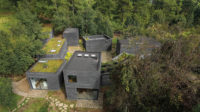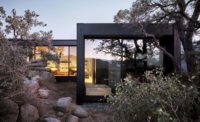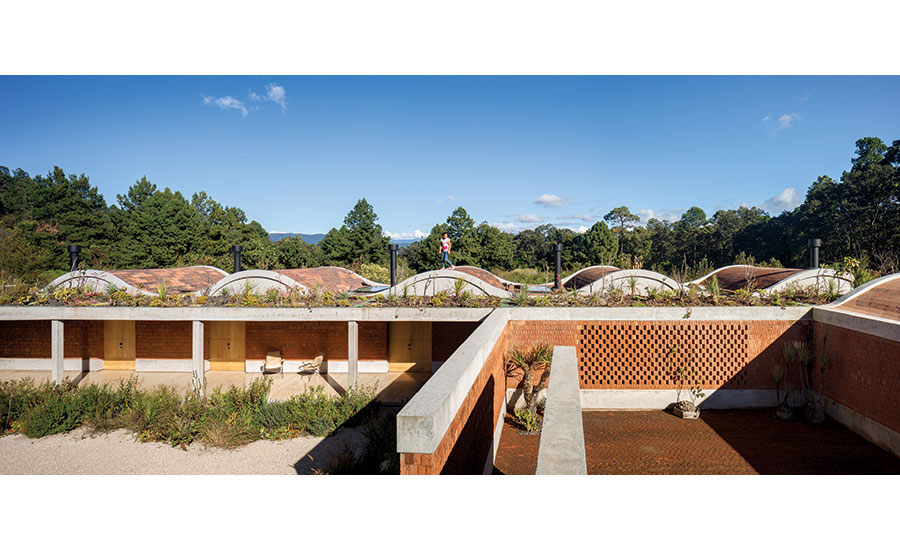Casa Terreno by Fernanda Canales
Estado de México

Casa Terreno sits on a relatively flat piece of property in the midst of rugged surroundings, and has four courtyards interspersed among its interior living spaces.
Photo © Rafael Gamo

You enter the house through an irregularly shaped patio defined by a curved brick wall and then proceed into a small skylit chamber, which is also made of brick, including its gabled roof.
Photo © Rafael Gamo

You enter the house through an irregularly shaped patio defined by a curved brick wall and then proceed into a small skylit chamber, which is also made of brick, including its gabled roof.
Photo © Rafael Gamo

A combination of vaulted and flat roofs shelter the house. These can be reached via a stair in one of the courtyards, offering an unusual perspective on the constantly changing landscape.
Photo © Rafael Gamo

A combination of vaulted and flat roofs shelter the house. These can be reached via a stair in one of the courtyards, offering an unusual perspective on the constantly changing landscape.
Photo © Rafael Gamo

In all the interior living spaces, including the bedrooms (shown), the kitchen, and the living room, the material palette consists almost exclusively of the poured-in-place concrete roof slabs and vaults, formed with reusable wood molds, and wood floors and millwork in local oak.
Photo © Rafael Gamo

In all the interior living spaces, including the bedrooms, the kitchen (shown), and the living room, the material palette consists almost exclusively of the poured-in-place concrete roof slabs and vaults, formed with reusable wood molds, and wood floors and millwork in local oak.
Photo © Rafael Gamo

In all the interior living spaces, including the bedrooms, the kitchen, and the living room (shown), the material palette consists almost exclusively of the poured-in-place concrete roof slabs and vaults, formed with reusable wood molds, and wood floors and millwork in local oak.
Photo © Rafael Gamo

Image courtesy Fernanda Canales









Architects & Firms
If you know the work of a particular architect well, you can often spot his or her preferred forms, identify favored materials, or discern a particular aesthetic. But that is not the case with the buildings of Fernanda Canales, a Mexican architect known for her small but polished body of work. Each of her projects looks as though it could have been created by a different designer. Among her single-family residences, one urban house is a Modernist composition of crisp, overlapping and projecting white concrete boxes, while another, in a popular vacation area, is a rustic assemblage of stone-enclosed volumes with pitched roofs supported by exposed timber structure. And her Casa Bruma, in a secluded community about 100 miles southwest of Mexico City, is a village-like cluster of discrete one- and two-story structures formed in assertive black concrete.
Additional Content:
Jump to credits & specifications
Her most recent house, Casa Terreno, a weekend retreat for her own family, has yet another expression. The 6,500-square-foot residence, in the same remote development as Bruma, is a horizontal ensemble of textured red brick walls and terra-cotta-tiled barrel vaults. As diverse as these projects might sound, however, they have a strong commonality: all are conceived around open-air living spaces, building on the long tradition of the courtyard in Mexican architecture. It is a theme Canales returns to again and again, “even though the formal solution is always different,” she says.
This newest project has not one but four such courtyards. These outdoor spaces are of various sizes and shapes and are interspersed among the elements of the one-story compound, which include a wing of four bedrooms, each under its own barrel-vaulted ceiling and each facing east toward the morning sun; an open-plan living/dining room under a larger vault; and flat-roofed volumes for the kitchen and the caretaker’s apartment. While providing daylight and fresh air, the voids break down the scale of the overall structure. But, according to Canales, they also bring a human scale to the spectacular landscape, which feels especially vast at night. This drama should be preserved, at least for the foreseeable future: Terreno, along with Bruma, is among a handful of houses completed so far on the community’s 500 largely untamed acres, which for decades had been used for cattle grazing and logged for its once-plentiful supply of old-growth oak trees. The developers aim to keep the wild feel intact, capping the total number of residences at only 70.
Amid this rugged and sparsely populated terrain, the house’s immediate 2.5-acre site is level, with few mature trees to provide shade from the often intense sun. Canales chose to emphasize its flatness, not only with the low-lying architecture, but also with her choice of plants for the area surrounding the complex and within some of the courtyards, including small fruit trees, flowering shrubs, and other, mostly ground-hugging, vegetation. During the dry season, which stretches from November through April, this flora, along with plantings on the flat roofs, turns reddish brown, like the brick exterior, camouflaging the house. Similarly, during the region’s extended rainy season, Terreno also nearly disappears in the mist that often shrouds the site.
You enter Terreno through the curved brick wall of an irregularly shaped patio and proceed through a small skylit chamber, which, including its gabled roof, is also made of brick. The almost crypt-like room is intended, says Canales, to accentuate the sense of arrival. This unusual space opens onto a central courtyard and an arcaded walkway from which the interior living spaces flow: brick gives way to a different material palette, with the vaulted ceilings cast in exposed poured-in-place concrete and the floors and built-ins made of local oak, the grain of the millwork echoing that left in the concrete from the forms used during construction. The overall effect is simple yet refined, with generously proportioned rooms, and an aura of coolness and calm.
Canales’s design approach was highly resourceful, making the most of the limitations of building in such a remote location. The bricks, for instance, were manufactured nearby. But the architect, predicting that many would be damaged during transport on winding and unpaved roads, decided to use intentionally broken brick. These are “torn” in half, with the rough face exposed, creating an unusual and rustic wall surface.
This practical mindset extends to the operating strategy, and almost every element of the house performs double duty. The roofs filter and collect rainwater, directing it to a 26,000-gallon cistern below the central patio, which is Terreno’s sole source of water (sewage is treated on-site). And because the rooftops are accessible by way of a stair in one of the courtyards, they also are a vantage point for taking in the spectacular landscape, even offering views—on a clear day—of the Nevado de Toluca, a volcano about 20 miles away. The house has solar panels for electricity and hot water, but no mechanical heating or cooling systems: its 18-inch-thick brick walls and the concrete roof, in addition to serving as support and enclosure, provide thermal mass. These hefty structural components, along with wood-burning fireplaces and operable windows, are sufficient to keep the interiors comfortable—despite fluctuating climatic conditions and temperatures that can swing more than 30 degrees Fahrenheit over the course of 24 hours. “We get winter and summer all in one day,” jokes Canales.
The constant change is what Canales loves about staying at the house—the rapidly moving clouds, the lifting of the mist, and the shifting colors of the hillsides. And with Casa Terreno, she has created a welcoming and intelligently designed retreat from which to appreciate the ever-evolving backdrop. “Every time we come,” she says, “it is a new place.”
CreditsArchitect: Fernanda Canales - Jurisprudencia 13, Copilco, 04360, Mexico City - +52 1 55 2699 1696 - www.fernandacanales.com
Structural: Gerson Huerta - Grupo SAI
General contractor: Felipe Nieto
Rafael Gamo |
SpecificationsKitchen appliances: Piacere
Windows Metal frame: Cortizo
Hardware Locksets: Arquideco
Interior Finishes Cabinetwork and custom woodwork: Óscar Nieto Floor and wall tile: Mármoles Arca |














